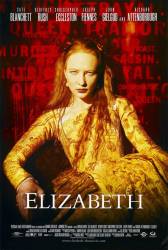Factual error: Sir Francis Walsingham was only a year older than Elizabeth.
Factual error: Elizabeth was arrested and sent to the Tower in 1554, but was then placed under house arrest at Woodstock (not Hatfield) for four years.
Factual error: Elizabeth did not start wearing wigs and heavy makeup until later in her reign, and although it was a combination of vanity and political shrewdness, it had nothing to do with the Virgin Mary. Elizabeth very much wanted to keep the image of an eternally youthful Queen, both for her own vanity, and to belie the fact that she was aging, and possibly weak or ill. Also, all this is intended to covere up the elderly monarch's smallpox scars. "As Elizabeth grew older and grayer, she took to wearing red wigs." "Elizabeth was 25 years old at her accession. From her father she had her red, naturally curly hair." - Alison Weir, the author of 'The Life of Elizabeth I' wrote. "Gloriana [a title referring to the Queen in her latter years] was almost 60 and had resorted to an auburn wig to hide her thinning hair." - Antonia Fraser, the author of 'The Lives of the Kings & Queens of England.'
Factual error: The Pope did not excommunicate Elizabeth, thus making her fair game for Catholic assassins, until 1570.
Factual error: Elizabeth was nearly twenty years older than the flamboyant, bisexual transvestite Duke of Anjou, and they never met in person. He went on to become King Henry III of France, and his younger brother became Duke of Anjou. It was this Duke that Elizabeth met, and they actually got along very well and even talked about getting married. However, due to unpopular public sentiment towards the match and Elizabeth's own aversion to marriage in general, the plans were called off.
Factual error: In the scene where Elizabeth is being taken to see her sister, Mary, she is in a horse-drawn carriage. Horse-drawn carriages, however, were not introduced to England until late in Elizabeth's reign, and at this point in the movie she is not yet queen.
Factual error: Mary of Guise did die mysteriously in 1560, but far from being near victory she was actually on the verge of defeat by an allied army of Scottish rebels and English troops.
Factual error: Queen Mother Mary of Guise did garrison Scotland with troops, but Elizabeth sent a fleet, not an army. And this fleet was not an invasion force, but was sent to back up the Protestant landlords in their battle against the Catholic Mary.
Factual error: The real Duke of Anjou did not become Elizabeth's suitor until 1571, long after her accession to the throne, when relations with France had improved greatly. He was not the nephew of Mary of Guise (as in the film), but the son of Catherine de Medici.
Factual error: Given that Elizabeth was under house arrest (at the beginning of the film), it is very unlikely she would be allowed to be with Robert Dudley, notwithstanding alone. They would also never had embraced and kissed in front of an audience sent by Queen Mary. Elizabeth was much higher born and considered a princess (despite being called a bastard by many) so etiquette would never allow young Dudley to behave this way in public.
Factual error: Walsingham did not trap and arrest Norfolk. Norfolk was executed in June 1572. Walsingham was then in Paris as English ambassador and returned to England in May 1573. (see "Her Majesty's Spymaster" by Stephen Budiansky).
Factual error: Bishop Stephan Gardiner is named as one of the traitors and is mysteriously murdered near the end of the film. In fact, he died from natural causes in 1555 during the reign of Mary I.
Factual error: The parliamentary bill to establish the Anglican Church was forced through the first session of Parliament by Cecil (not Walsingham), using more complex means than that portrayed in the film. He effectively became the first government whip, using many techniques, the most important being a procedural device that limited debate to that which was justified by Scripture alone. The Catholic MP's walked out in protest. The two ringleaders of the protest were taken to the Tower of London.
Factual error: In one scene, Elizabeth proposes to the bishops of England that they create a "single Church of England." In reality, the Church of England existed since as early as the 7th century. It was Henry the VIII, her father, who pushed Parliament to sever the Church of England from Roman Catholic jurisdiction in successive acts in 1529 and 1536. He did so out of anger at Pope Clement VII, who would not let him divorce Catherine of Aragon. The Bishops did not protest this, but were instead delighted at the idea, because they didn't have to change how they worshiped and it reaffirmed the position of the monarch as "Christian prince" or supreme leader of the Church (i.e. Charlemagne). The Church was restored to Catholic rule under Mary I, but was severed again only with Elizabeth's excommunication and not by an act of English bishops (who really had no say).





